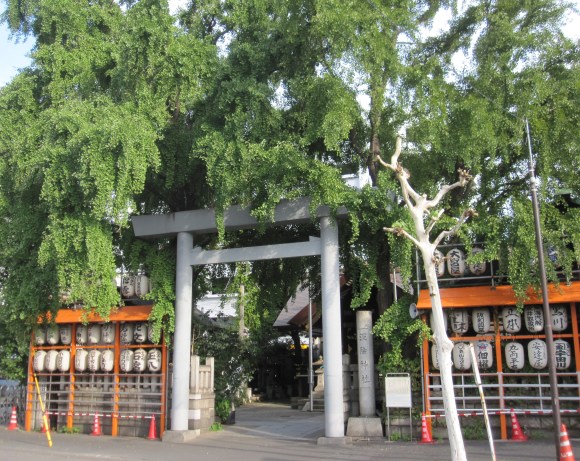
The other day, I woke up and immediately had a craving for sushi. In and of itself, that’s not really anything remarkable, since “Man, I could really go for some good sushi,” is one of my first fully formed thoughts on just about any given morning.
Not one to deny my heart its truest desires, I headed to Tokyo’s Tsukiji, home of the world’s biggest seafood market and some of Japan’s best sushi restaurants. I ducked into one and polished off a bowl of sliced tuna and salmon, and, still wrapped in the lingering effects of my food coma, went for a rambling stroll around the neighborhood.
Since I wasn’t looking for food anymore, my eyes ended up being drawn to a shrine I’d never noticed before. I stepped onto the grounds, where I found a monument to the souls of all the fish whose lives supply Japan with sushi.
Namiyoke Inari Shrine wasn’t established specifically for this purpose, nor is the sushi monument its primary claim to fame. That honor goes to the two giant lions’ heads housed there, which are both over 150 years old and are paraded around the neighborhood in an annual festival each July.
But while the sushi monument may not be as dynamic in appearance, it arguably has the deeper significance.
▼ Sushitzuka, or Grave of Sushi, is carved into the stone.
In Japan, it’s customary to say “itadakimasu” before you start eating, whether you’re about to enjoy a seven-course feast or a bite-sized snack. To people with a Christian background, it might seem a little like saying grace, but the phrase itadakimasu isn’t a prayer. It just means, “I will receive.”
But just what is it soon-to-be diners are receiving? One school of thought holds that the phrase shows gratitude to the cook or purchaser and means, “I will receive the food that you have prepared for me.” Another belief, though, is that itadakimasu is a sign of respect towards the animals and plants that nourish us. In other words, the context is, “I will receive your life.”
With over 700,000 metric tons of seafood moving through the Tsukiji fish market each year, Japan is receiving a lot of aquatic life. Looked at from that perspective, a simple memorial is the least mankind can do to say, “Hey, thanks for letting us eat you.”
Of course, not all the fish sold at Tsukiji is made into sushi. A lot of it ends up as sashimi, grilled, or stewed. So to make sure every base is covered, there’s also a stone marking The Grave of Fish.
Some of you might be wondering who paid for these markers. After all, when we talk about “the bounty of the sea,” we’re not usually referring to financial assets. Are the relatives of the deceased fish purchasing these memorial stones with sunken pirate gold?
Actually, merchants, wholesalers, and other businesses are the ones who footed the bill. Remember that huge quantity of seafood that gets sold at Tsukiji? It translates out to over 600 billion yen (US $555 million) in sales during the year. It’s not just diners who’re thankful for all that tasty fish, but the thousands of people whose livelihoods depend on it, too.
That’s also part of the reason why the monuments are extra thorough. Just like there’s an extra stone for non-sushi fish, there’s also one for shrimp.
If you’ve ever enjoyed a set of mixed tempura (and if you haven’t you’re missing out on one of the highest forms of fried food, which is saying quite a lot), then you know tempura shrimp are usually the stars of the meal. It’s such a popular ingredient that there’s a second, smaller shrimp memorial for those used to make tempura, seen on the left here.
Anglerfish is another high value-added menu item, so it gets a monument too.
As kind as the sentiment is behind all of these, though, visitors who can’t read Japanese are likely to pass by without any understanding of the stones’ meaning. You can’t say that about this one, though.
Eggs have long been the friend of sushi neophytes who aren’t quite ready to make the leap into eating raw fish. Japanese-style tamagoyaki fried egg on a stick is also a sleeper hit of the Tsukiji food stall scene, hence its inclusion here.
Namiyoke Inari Shrine is located at the end of the street serving as the edge of Tsukiji’s Outer Market, and just steps away from the gate to the Inner Market. So if you find yourself in the neighborhood and want to do something to say thanks for, and to, all the fish, consider stopping by and tossing a five-yen coin in the collection box.
Shrine information
Namiyoke Inari Shrine / 波除稲荷神社
Address: Tokyo-to, Chuo-ku, Tsukiji 6-20-37
東京都中央区築地6-20-37
Website
Photos: RocketNews24